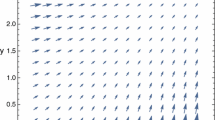The continued absence of positive results for the direct detection of gravitational waves may be related to the existence of fundamental limits on the primary emission power for these waves from astrophysical objects. Some mechanisms, known and under study, for the shedding of the energy of gravitational waves via other radiation channels are discussed.
Similar content being viewed by others
References
E. T. Frantsuz, “Fundamental physical constants in the new international system of units,” Izmer. Tekhn., No. 3, 7–9 (2010); Measur. Techn., 53, No. 3, 228–231 (2010).
K. A. Bronnikov et al, “Current problems in fundamental metrology,” Izmer. Tekhn., No. 4, 27–34 (2010); Measur. Techn., 53, No. 4, 391–401 (2010).
“The LIGO Scientific Collaboration and the Virgo Collaboration. An upper limit on the stochastic gravitational-wave background of cosmological origin,” Nature, 460, 990–994 (2009).
J. H. Taylor, Jr., “Double pulsars and relativistic gravitation. Nobel lecture,” Usp. Fiz. Nauk, 164, No. 7, 757–764 (1994).
J. M. Weisberg and J. H. Taylor, “The relativistic binary pulsar B1913 + 16: Thirty years of observations and analysis,” in: F. A. Rasio and I. H. Stairs (eds.), Binary Radio Pulsars: Proc. Aspen Winter Conf., Aspen, CO, USA, (2004), Vol. 328, pp. 25–32.
P. Astone et al., “Study of the coincidences between the gravitational wave detectors EXPLORER and NAUTILUS in 2001,” Class. Quantum Grav., 19, 5449–5463 (2002).
L. S. Finn, “No statistical excess in EXPLORER/NAUTILUS observations in the year 2001,” Class. Quantum Grav., 20, L37–L44 (2003).
V. V. Schmidt, Introduction of Superconductivity [in Russian], Nauka, Moscow (1982).
H. Störmer, “Fractional quantum hall effect. Nobel lecture,” Usp. Fiz. Nauk, 170, No. 3, 304–319 (2000).
M. Kobayashi, “CP-violation and mixing of flavors. Nobel lecture,” Usp. Fiz. Nauk, 179, No. 12, 1312–1318 (2009).
A. S. Chou et al., “Search for axion like particles using a variable baseline photon regeneration technique,” Phys. Rev. Lett., 100, 080402 (2008).
P. Pugnat et al., “Results from the OSQAR photon regeneration experiment: No light shining through a wall,” Phys. Rev. D, 78, 09200 (2008).
A. Afanasev et al., “Experimental limit on optical photon coupling to light neutral scalar bosons,” Phys. Rev. Lett., 101, 12040 (2008).
S. Andriamonje et al., “Hidden laser communication through matter,” J. Cosmol. Astropart. Phys., No. 7, 04010 (2007).
P. Sikivie, D. B. Tanner, and K. van Bibber, “Resonantly enhanced axion-photon regeneration,” Phys. Rev. Lett., 98, 172002 (2007).
J. Jackel, J. Redondo, and A. Ringwald, “Hidden communication through matter – an application of meV-scale hidden photons,” EPL, 87, 10010 (2009).
J. Jaeckel and A. Ringwald, “Search for hidden sector photons with the ADMX detector,” Phys. Rev. Lett., 105, 171801 (2010).
M. Ahlers et al., “Laser experiments explore the hidden sector,” Phys. Ref. D, 77, 095001 (2008).
V. S. Gorelik, “Optics of globular photon crystals,” Kvant. Elektr., 37, 409–432 (2007).
A. S. Chou et al., “Search for chameleon particles using a photon-regeneration technique,” Phys. Rev. Lett., 102, 030402 (2009).
B. F. Schutz, Gravitational Radiation Encyclopedia of Astronomy and Astrophysics, IOP Publ., Macmillan, London (2000).
L. P. Grishchuk, “Relict gravitational waves and cosmology,” Usp. Fiz. Nauk, 175, No. 12, 1289–1303 (2005).
Y. Fukuda et al., “Evidence for oscillation of atmospheric neutrinos,” Phys. Rev. Lett., 81, 1562–1567 (1998).
J. N. Bahcall and C. Peña-Garay, “A road map to solar neutrino fluxes, neutrino oscillation parameters, and tests for new physics,” JHEP, 11, 004 (2003).
G. Pagliaroli et al, “Neutrinos from supernovae as a trigger for gravitational wave search,” Phys. Rev. Lett., 103, 031102 (2009).
B. Greene et al., “Cosmological moduli dynamics,” JHEP, 7, 060 (2007).
G. G. Barnaföldi, P. Lévai, and B. Lukács, “Searching extra dimensions in compact stars,” Astron. Nachr., 328, Iss. 8, 809–812 (2007).
W. C. C. Lima, G. E. A. Matsas, and D. A. T. Vanzella, “Awaking the vacuum in relativistic stars,” Phys. Rev. Lett., 105, 151102 (2010).
W. C. C. Lima and D. A. T. Vanzella, “Gravity-induced vacuum dominance,” Phys. Rev. Lett., 104, 161102 (2010).
Author information
Authors and Affiliations
Corresponding author
Additional information
Translated from Izmeritel’naya Tekhnika, No. 5, pp. 6–10, May, 2011.
Rights and permissions
About this article
Cite this article
Izmailov, G.N. Transverse cross section of gravitational antennas, the stiffness of the vacuum, and the weakness of gravitational waves. Meas Tech 54, 479–485 (2011). https://doi.org/10.1007/s11018-011-9752-6
Received:
Published:
Issue Date:
DOI: https://doi.org/10.1007/s11018-011-9752-6




